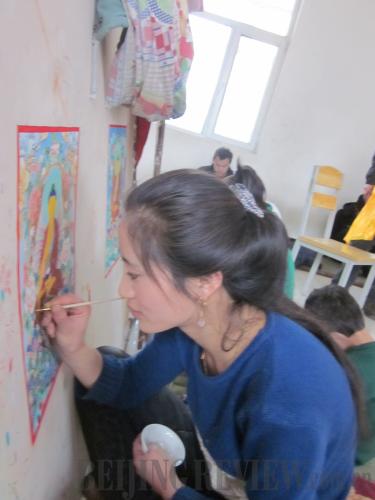|
 |
|
CULTURAL INHERITANCE: A girl at Longshu Art Gallery learning to paint tangka (PANXIAOQIAO) |
Longshu Art Gallery is located in Tongren County, around 180 kilometers of Qinghai's capital city Xining in northwest China.
Wan De is a 30-year-old painter at the gallery. He has been learning tangka for nearly 13 years.
Tangka are scroll paintings that were first developed in the 7th century. From religious to historical stories, and from social activities to well-known characters, the artform feature all aspects of Tibetan people's lives.
As the content of tangka are mostly related to Buddhism and they are painted in a style is simple and beautiful, tangka is widely popular in Tibetan Buddhism monasteries.
According to Wan, every year, they receive a huge amount of orders from temples in Qinghai and other parts of China. For example, the frescoes at the Tar Monastery, one of the six most important monasteries of the Gelug (Yellow Hat) Sect of Tibetan Buddhism, were all painted by this art gallery. The work has been going on for nine years, and is yet to be finished. Outside Qinghai, in Wutaishan Mountain, which is famous for its Buddhist culture, as many new temples have been erected, the demand for tangka has grown enormously. Some works are done here in the art gallery, but frescoes must been done on site by experienced painters that the gallery sends.
Due to the close connection between tangka and Buddhism, a good painter is first required to have virtue and a good understanding of Buddhism. "Every time I begin to work on a new tangka, I always read Buddhist scriptures first to make myself peaceful," Wan noted.
Tangka is not easy to learn. Every student is required to learn about seven or eight years before they can "graduate." It is painted using mineral pigments and brushes made from cat fur. Moreover, it tends to be classified according to their dominant color, with black tangka requiring for the most sophisticated techniques. A ccording to tradition, black tangka can also not be done with the assistance of reference materials and only the most skilled artists can undertake the painting of one.
During the first two or three years' learning, artists studying tangka will draw and paint on paper, practicing the basic techniques, such as how to use mineral pigments and the proportions the parts of figures in the paintings.
Most students in the art gallery are children from families with economic difficulties, but they are talented in tangka. After about eight years' of learning, they become familiar with the concepts of tangka and its techniques, which will help them to support themselves. Meals and accommodation is free of charge, and students also receive commision from the tangka of theirs that are sold.
Without having to worry about finances, students can focus on their work. This is an effective way to help preserve the art form of tangka.
"Nowadays, more and more people know about tangka, and know that it is on the World Intangible Cultural List. We'll continue to uphold the traditional methods and techniques of tangka, and we hope it can become known not only around China but around the world," Wan noted.
(Reporting from Qinghai Province) | 